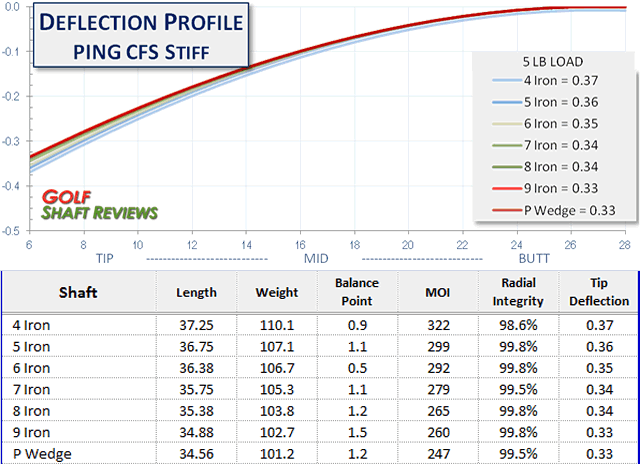PING CFS Iron Shafts
By Russ Ryden, A Golf Digest America’s 100 Best Clubfitter
Fit2Score, Dallas Fort Worth, Texas
As a club fitter it is important to know what your are fitting with and the makeup of my customers existing clubs clubs. I did a reshaft of a set of Ping irons recently and had a chance to profile the pull outs. Here is what I measured:
To continue reading this section of the review, you must be registered at a higher level membership.
Russ
 For comparison with other shafts on this site, the 6 iron butt stiffness was 12.9 lbs. Tip to butt ratio was 56%, indicating a mid launch. This is a parallel shaft with a .370 tip. That can be seen in the descending weight as the shafts get shorter. To some degree, the tip stiffness compresses through out the set. This can be seen by looking at the range of mid shaft stiffness compared to tip and butt stiffness range. This is typical in sets made from the same shaft that have the tip section shortened to create additional stiffness as the club heads in the heads get heavier.
For comparison with other shafts on this site, the 6 iron butt stiffness was 12.9 lbs. Tip to butt ratio was 56%, indicating a mid launch. This is a parallel shaft with a .370 tip. That can be seen in the descending weight as the shafts get shorter. To some degree, the tip stiffness compresses through out the set. This can be seen by looking at the range of mid shaft stiffness compared to tip and butt stiffness range. This is typical in sets made from the same shaft that have the tip section shortened to create additional stiffness as the club heads in the heads get heavier.
What I have seen in measuring other sets of Ping irons was that they achieved both swing weight matches and were very close to MOI matches. I regret not having measured this set before I pulled it apart. The descending weight caused a fairly substantial change in the shafts contribution to the total MOI of the club. Perhaps this is why I have seen swing weight and MOI matched sets of Ping irons.[\resrict]


